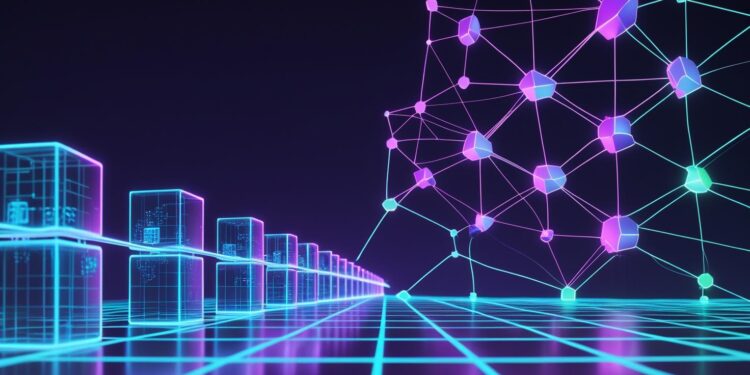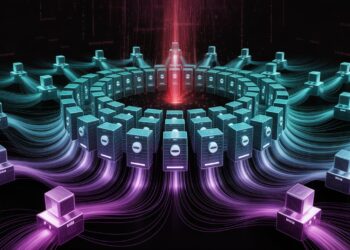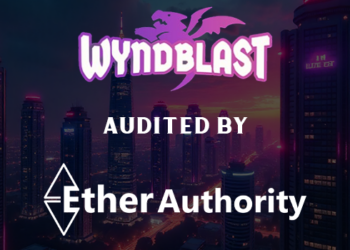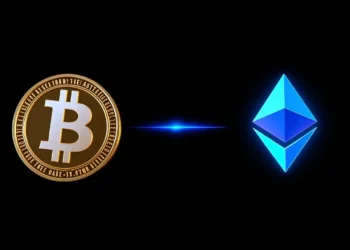Imagine Bitcoin transactions taking hours, even days, to confirm. Picture hefty fees eating into every transaction. These are real issues with current blockchain technology. Directed Acyclic Graphs (DAGs) offer solutions. They are revolutionizing how we think about digital transactions. This article offers a comparison of DAGs and traditional blockchains. We will explore what makes each unique. We’ll look into their advantages and disadvantages.
Understanding Traditional Blockchains
Blockchains are the base for cryptocurrencies like Bitcoin. But how do they actually work? Understanding the basics is key. This understanding helps to see the differences between blockchains and DAGs.
Blockchain Structure: Blocks, Chains, and Cryptography
Think of a blockchain as a digital ledger. This ledger is made of blocks. Each block contains transaction data. These blocks are chained together using cryptography. Cryptography secures the data. Each block contains a hash of the previous block. This forms a chain. If someone changes a block, the hash changes. This change breaks the chain. This makes blockchains very secure.
Consensus Mechanisms: Proof-of-Work, Proof-of-Stake, and Beyond
Consensus mechanisms are the rules that validate transactions. Proof-of-Work (PoW) is used by Bitcoin. Miners solve complex problems. This verifies transactions. Then they add new blocks to the chain. This process requires lots of energy. Proof-of-Stake (PoS) is more energy-efficient. Validators are chosen based on their holdings of the cryptocurrency. They validate transactions and create new blocks. Delegated Proof-of-Stake (DPoS) and Proof-of-Authority (PoA) are other ways to validate transactions.
Limitations of Traditional Blockchains: Scalability, Speed, and Cost
Blockchains have limitations. Bitcoin can process only about seven transactions per second (TPS). Ethereum can handle about 15 TPS. These speeds are slow. They’re especially slow when compared to systems like Visa. High transaction fees are a thing too. This becomes a problem during peak usage. The scalability, speed, and cost are major hurdles.
Exploring Directed Acyclic Graphs (DAGs)
DAGs offer a different approach to distributed ledgers. They change how transactions are validated. This provides potential improvements in speed and scalability. Let’s dig in.
DAG Structure: Vertices, Edges, and the Absence of Blocks
DAGs do not use blocks. Instead, they use vertices and edges. Vertices represent individual transactions. Edges show the validation relationship between transactions. Each new transaction must validate one or more previous transactions. This creates a graph-like structure. This structure allows for concurrent transaction processing.
Transaction Validation in DAGs: Concurrency and Efficiency
In DAGs, transactions validate each other. There isn’t a need to wait for miners or validators. Multiple transactions can be validated at the same time. This leads to faster confirmation times. This makes the system more efficient. DAGs eliminate the bottlenecks found in traditional blockchains.
Notable DAG Implementations: IOTA, Hashgraph, and Nano
IOTA is a DAG-based platform for the Internet of Things (IoT). It focuses on fee-less transactions and data integrity. Hashgraph uses a gossip protocol. This reaches consensus quickly and efficiently. Nano is designed for fast, fee-less transactions. Each DAG implementation has its own approach. They tackle different challenges in the distributed ledger space.
DAG vs. Blockchain: A Head-to-Head Comparison
DAGs and blockchains both offer ways to record transactions. Yet they have very different strengths and weaknesses. Let’s compare them side by side.
Scalability: Transactions Per Second (TPS) and Network Capacity
DAGs generally offer better scalability than blockchains. They handle more transactions per second (TPS). This is because of their concurrent transaction processing. Blockchains are limited by their block creation time and block size. This puts a limit on network capacity.
Transaction Fees: Cost-Effectiveness for Microtransactions
DAGs often have lower transaction fees than blockchains. Some DAG platforms even offer fee-less transactions. Blockchains usually need fees to compensate miners or validators. DAGs are more cost-effective for microtransactions. Blockchains aren’t suited for small payments.
Security: Vulnerabilities and Attack Vectors
Blockchains are secured by cryptographic methods. They also use consensus mechanisms. DAGs face different security challenges. One concern is the potential for “nothing at stake” attacks. This is where validators can validate conflicting transactions without penalty. Both technologies are at risk of Sybil attacks. Here, an attacker controls a large portion of the network. More research and development is needed to increase security.
Decentralization: Node Participation and Governance
Blockchains are designed to be decentralized. No single entity controls the network. DAGs also aim for decentralization. However, the structure influences how decentralization is achieved. Blockchains typically have a clear structure for node participation. DAGs have varied governance models. The best approach is still being discussed.
Advantages and Disadvantages of DAGs
DAGs bring some benefits to the table. Yet it’s good to recognize their possible drawbacks. Weighing the pros and cons helps. It helps to understand where DAGs fit best.
Advantages: Speed, Scalability, and Low Fees
DAGs offer impressive speed. Transactions can be confirmed much faster compared to blockchains. Scalability is another advantage. DAGs handle a higher volume of transactions. They’re more efficient. Low transaction fees are a major benefit. They’re making DAGs ideal for micropayments.
Disadvantages: Security Concerns and Network Effects
Security can be a concern. DAGs are new technology. This means they face potential vulnerabilities. Network effects are also important. A DAG network becomes more secure. It improves as more users participate. Small networks can be more vulnerable to attacks.
Use Cases and Applications: Where DAGs Shine
DAGs excel in specific applications. Their unique features unlock new possibilities. Let’s explore some use cases.
Internet of Things (IoT): Micropayments and Data Integrity
DAGs are a natural fit for the Internet of Things (IoT). IoT devices often need to make small payments. DAGs provide a way to handle these micropayments without high fees. DAGs help to ensure the integrity of data collected by IoT devices.
Supply Chain Management: Tracking and Traceability
Supply chain management benefits from DAGs. They provide enhanced tracking and traceability. Each product movement can be recorded as a transaction on the DAG. This creates a transparent and auditable record.
Data Storage and Management: Efficient and Scalable Solutions
DAGs are suited for data storage and management. They offer efficient and scalable solutions. Data can be distributed across the network. This ensures that there is no single point of failure.
Conclusion
DAGs and blockchains represent different approaches to distributed ledger technology. Blockchains offer security and decentralization. DAGs provide speed, scalability, and low fees. DAGs address the limitations of traditional blockchains. They pave the way for new applications and use cases. As distributed ledger technology continues to advance, DAGs will play a major role. They will change how we think about digital transactions and data management.
Join Us : Twitter | Website | GitHub | Telegram | Facebook | YouTube

























